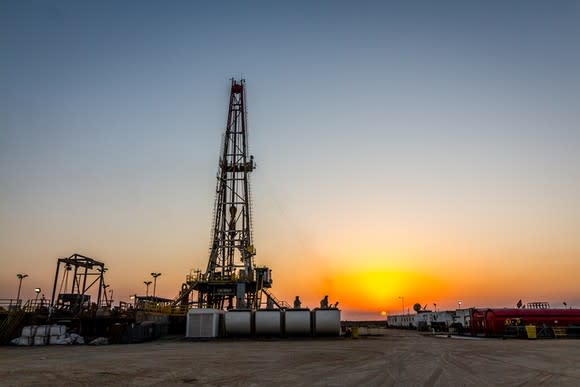Why You're Smart to Buy This Beaten-Up Dividend Stock
Oil and gas experts are closely watching the Permian Basin in 2018. That's hardly surprising, considering it's the largest and fastest-growing energy play in the United States. But some are worried that it may be growing too fast.
The Permian Basin has grown crude oil production from 1.5 million barrels per day (bpd) entering 2014 to over 3.1 mbp today -- and that doesn't include natural gas (it's the second-largest gas play in the country) or other petroleum liquids. Current growth trends and expansion projects predict that crude oil output will rise to over 5 mpd sometime in 2023. That would be more than the entire United States produced in 2008.
While production growth is great, it's possible to grow too fast. If takeaway capacity from pipelines, processing centers, and storage tanks doesn't keep pace, the region could drown in a sea of dinosaur sauce. That would tank prices in the Permian and stunt investment in new production. Luckily, pipeline operators such as Plains All American Pipeline LP (NYSE: PAA) are working to avoid such a scenario. That makes the beaten-up dividend stock worth a closer look.

Image source: Getty Images.
Analysts warn of a Permian bottleneck
Multiple outlets, from The Wall Street Journal (subscription required) to Reuters, have weighed in on the potential for Permian Basin crude oil production growth to exceed pipeline capacity. According to Oilprice.com, the International Energy Agency estimates that spare pipeline capacity in the region was just 160,000 bpd at the end of 2017 and predicted that a deficit was possible in the second half of 2018.
While the gap between production and takeaway capacity in the Permian Basin is certainly tight right now, numerous pipeline operators in the region are bringing new pipeline extensions on line in the near future.
For instance, Enterprise Products Partners LP (NYSE: EPD) just announced that its Midland-to-Sealy pipeline for crude oil and condensate is now on line. The entire 540,000 bpd capacity is subscribed in long-term contracts, while minor expansions will boost it to 575,000 bpd next month. Another 300,000 bpd project in the Delaware Basin (part of the Permian Basin) is scheduled to come on line in July 2018.
Plains All American has similarly ambitious growth plans in the Permian, but unlike Enterprise, which focuses primarily on natural gas and natural gas liquids, the company is mainly focused on crude oil. The length of its crude oil pipelines in the Permian Basin alone nearly matches that of Enterprise's entire crude oil pipeline portfolio.

Image source: Getty Images.
The company's existing footprint in America's most strategically important energy formation provides a notable opportunity to take advantage of the pending bottleneck. Plains All American Pipeline will add roughly 700,000 bpd of crude oil offtake capacity to its robust network in the Permian when its Cactus II and Sunrise extension projects come on line by the third quarter of 2019. Additional incremental expansions will come on line in the following quarter.
The pipeline operator is spending $1.95 billion on growth projects across its entire North American portfolio in 2018 and 2019, with $1.61 billion contained within the Permian Basin. Most of that will be funded with a combination of $700 million in expected proceeds from asset sales and $600 million in retained cash flow.
It all will be easier thanks to robust growth in operating cash flow in 2017. Plains All American Pipeline delivered $2.5 billion in cash flow from operations, supported by record volumes for its pipeline, facilities, and logistics segments. While much of that has been retained to fund capital projects and deleverage the balance sheet (aided by $1.1 billion in asset sales last year), there's considerable potential to begin returning more cash flow to shareholders in the coming years.
That's not to be taken lightly: The current annualized distribution per share is $1.20 -- less than half the $2.76 per share paid out in 2015. Besides, investors that own the stock today aren't exactly getting a raw deal. Plains All American Pipeline stock trades at a favorable valuation compared to other pipeline operators, including Permian peer Enterprise:
Metric | Plains All American Pipeline | Enterprise Products Partners |
|---|---|---|
Market cap | $19.6 billion | $57.9 billion |
Forward price-to-earnings ratio | 14.5 | 16.0 |
1.33 | 2.99 | |
Enterprise value-to-EBITDA ratio | 15 | 15.5 |
Data source: Yahoo! Finance.
Enterprise certainly earns a premium valuation thanks to its size and track record, but it's clear that Plains All American Pipeline is being weighed down by its turnaround. Nonetheless, the company has made tremendous progress reducing debt, improving profitability, and refocusing operations on core regions, such as the Permian Basin. Once the Cactus II and Sunrise extension come on line, Wall Street will have to take notice.
This pipeline stock is worth the wait
Analysts have warned that oil producers in the Permian Basin may encounter a production bottleneck due to a lack of takeaway capacity in the next year or two. Although there could be temporary constraints here and there, a survey of pipeline projects underway hints that the region will stave off a full-blown crisis.
Plains All American Pipeline figures to be one of the biggest winners. With growth projects coming on line in the next two years, there's considerable potential to grow an already healthy distribution yield in the not-too-distant future. That expected growth, coupled with a depressed share price from the ongoing turnaround, gives long-term investors a great opportunity.
More From The Motley Fool
Maxx Chatsko has no position in any of the stocks mentioned. The Motley Fool recommends Enterprise Products Partners. The Motley Fool has a disclosure policy.
